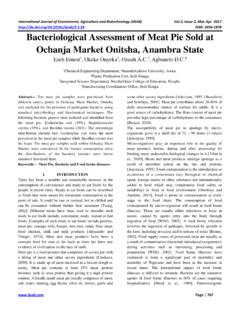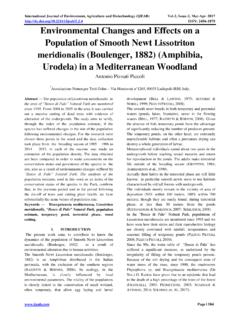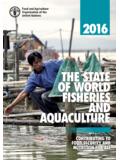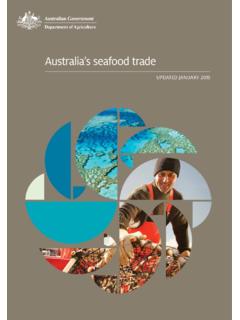Transcription of International Journal of Environment, Agriculture …
1 International Journal of Environment, Agriculture and Biotechnology (IJEAB) Vol-3, Issue-2, Mar-Apr- 2018 ISSN: 2456-1878 Page | 343 Effect of stocking density on growth performance of monosex tilapia (Oreochromis niloticus) with Indian spinach (Basella alba) in a recirculating aquaponic system Md. Zahir Rayhan1, Md. Arefin Rahman2*, Md. Amzad Hossain1, Taslima Akter1, Tasmina Akter3 1 Dept. of Aquaculture, Bangabandhu Sheikh Mujibur Rahman Agricultural University, Gazipur-1706, Bangladesh 2 Dept.
2 Of Aquatic Science, Prince of Songkhla University, Hat Yai, Thailand; 3 Dept. of Fisheries Management, Bangabandhu Sheikh Mujibur Rahman Agricultural University, Gazipur-1706, Bangladesh *Corresponding author and Email: Abstract An experiment was conducted to compare effect of stocking density on growth performance of monosex tilapia (Oreochromis niloticus) with Indian spinach (Basella alba) in a recirculating aquaponic system. The experiment was set-up for 8 weeks under 4 treatments with three replications, where stocking density of tilapia were 30, 50, 70 and 90 fish/tank (300 litre) in treatments T1, T2, T3 and T4, respectively. Water from the tank was recirculated through a vegetable growing tray.
3 Each of the tray was m3in size, which was planted with 12 plants (Indian spinach). The fish of all the treatments was fed two times a day. During the experimental period,the range of water temperature was to C, pH to , ammonia to mg/l and dissolve oxygen to mg/l. At the end of the experiment, average weight gain, final length, specific growth rate (%/day), survival rate was significantly higher in T1 (30 fish/tank) treatment while the net yield of fish and plant biomass was higher in T2 (50 fish/tank) , the study suggests that stocking density of 50 fish/tank for tilapia, 167 fish/m3, is suitable for production of both plant and fish in a recirculating aquaponic system.
4 Keywords Aquaponic, Stocking density, Tilapia, Indian spinach, Growth. I. INTRODUCTION The demand of aquaculture products is increasing to the consumers, together with the costs related with land and water and also increasing environmental constraints, have determined producers to advance their technological facilities or to implement new engineering solutions to assure the culture of high stocking densities, thus gaining enough fish supplies to cover the production costs and equally, to meet the marketed and s[1].To overcome such situation the aquaponics, an environmental friendly and sustainable food production system may be appeared as a weapon to fight against water scarcity, soil degradation, climate change and the increased population[2].
5 Aquaponics is a novel alternative method of fish and crop production system by combining aquaculture and hydroponics, a way of growing plants without using soil substrate. The elements which are essential for an aquaponic systemare fish rearing tank, a suspended solid removal component, a bio filter, a hydroponic component and a sump[3].In this method, plants filter waste product means ammonia which is harmful to the fish from the system and utilized them as a nutrient source[4].Very simply, the principle of aquaponic system is fish excrete contains potentially toxic nitrogen compounds, including ammonia which processed into nitrite and then nitrate by nitrifying bacteria which provided in the system.
6 Released ammonia by the fish is not only transformed to nitrate but also removed by the plants from the water [5].The plants utilize this biologically available nutrient from the water for growth, on the other hand, fishes get suitable water quality for their health that also decrease the need to replace water for the fish tanks[3], [6].In an aquaponics system, waste input in the fish tank is reduced through a closed looped system. This symbiotic relationship between fish and plants facilitates to produce multiple crops at a time that results in increased yields while reducing costs and maintenance[7]. In the aquaponic system water, energy and fish feed are the three main physical inputs although vary in size and type of production system[8].
7 There also need to createa balance of the macro- and micro-nutrient amount that fish can release in the water for a given feed in the aquaponic system; this highly depends on fish species, fish density, temperature, and type of plants[9].Now, it is clear that the supplied feed and stocking density is directly related to maintain the metabolites flow into the aquaponic system International Journal of Environment, Agriculture and Biotechnology (IJEAB) Vol-3, Issue-2, Mar-Apr- 2018 ISSN: 2456-1878 Page | 344 on the other hand, in aquaculture, stocking density is considered to be one of the important factors that affect fish growth, feed utilization, gross fish yield and economic returns[10], [11].
8 Tilapia has become the third most significant fish in aquaculture after carps and salmonids [12]. Nile tilapia is commonly cultured tilapia species all over the world that produced over 70% of the cultured tilapia[13]which is also a common choice in aquaponic system[4]. On the contrary, Basella alba or Indian spinach is a popular tropical leafy-green vegetable, commonly grown as backyard herb in the home gardens which is a rich source of Vitamin A and C[14].Therefore, the present investigation is carried out to identify the production of mono sex Nile tilapia and Indian spinach with varying stocking density in a recirculating aquaponic system. II. MATERIALS AND METHODS Site and design of the experiment The experiment was conducted for 8 weeks in a recirculating aquaponic system in the wet-field laboratory of Faculty of Fisheries, Bangabandhu Sheikh Mujibur Rahman Agricultural University, Gazipur, Bangladesh from 6 May to 6 July 2015.
9 The experiment was carried out in completely randomized design having four stocking density, (30, 50,70 and 90 fish/tank for T1, T2, T3 and T4, respectively) with triplicate. Setting up fish rearing tank and vegetable growing bed In this experiment, fish were reared in 12 circular plastic tanks having 300-liter capacity and vegetable were grown in rectangular trays prepared with steel sheet of (125 80 15) cm3 or m3 the vegetable growing trays were filled with small pieces of bricks (works as bio filter). Twelve water pumps (each of 12 watts) were used for elevating water from tank to tray. Fish rearing tanks were arranged arbitrary among the treatments.
10 All the settings were kept under a transparent polythene shed surrounded by bamboo fencing. In this systemfish ate food and release metabolites into the water derived from the food. The metabolites containing water was pumped in the vegetable bed. These metabolites were further metabolized by bacteria (living in small pieces of bricks), and the products of this metabolism were used by plants for nourishment. Rearing of fish, transplanting of vegetable and feeding The tilapia juvenileswere collected from a commercial hatchery, Mymensingh, Bangladesh. After acclimatizing and nursing up to desired sized (Table 5), the fingerlings were stocked in the rearing tank. On the other hand, Indian spinach seed were collected from the local market and were grown in the earthen bed up to 15-20 cm size of the seedlings (three weeks) having at least 2 3 true leaves.




